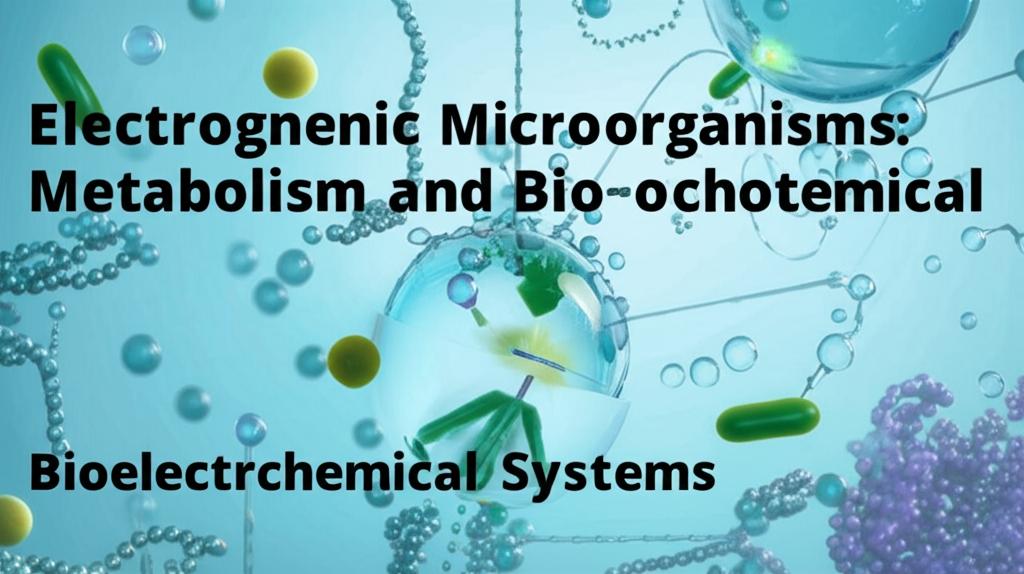Electrogenic microorganisms are fascinating microbes capable of transferring electrons outside their cells, interacting directly with conductive surfaces like electrodes. This unique ability, known as extracellular electron transfer (EET), forms the foundation for various bioelectrochemical systems (BES).
Metabolic Mechanisms of Electron Transfer:These microorganisms primarily generate energy through respiration, but instead of using oxygen as the final electron acceptor like humans, they can use external, solid-state electron acceptors. Key mechanisms for EET include:
- Direct Electron Transfer: Some bacteria, like Geobacter and Shewanella species, possess outer membrane cytochromes (proteins) that directly contact and transfer electrons to an electrode surface.
- Mediated Electron Transfer: Microbes can secrete soluble molecules, often called electron shuttles (like flavins), which pick up electrons from the cell and transport them to the electrode.
- Nanowires: Certain bacteria can produce conductive protein filaments, termed nanowires, which extend from the cell and facilitate long-range electron transport to external acceptors or even other cells, forming conductive biofilms.
Understanding the specific metabolic pathways is crucial. For instance, during anaerobic respiration, electrons generated from the breakdown of organic matter (like acetate or lactate) flow through the electron transport chain within the microbe. Instead of terminating with an internal acceptor, the pathway extends to the outer membrane components involved in EET.
Bioelectrochemical Systems (BES): Harnessing Microbial Power:BES technology leverages the metabolic activity of electrogenic microorganisms for various applications. The core principle involves using these microbes as biocatalysts at an electrode. Common types of BES include:
- Microbial Fuel Cells (MFCs): These devices convert the chemical energy stored in organic waste directly into electricity. Microbes at the anode oxidize organic matter, releasing electrons that travel through an external circuit to the cathode, where they typically reduce oxygen. MFCs offer a dual benefit of waste treatment and power generation.
- Microbial Electrolysis Cells (MECs): In MECs, a small external voltage is applied to assist the microbial breakdown of organic matter, driving the production of valuable chemicals like hydrogen gas or methane at the cathode. This process can be more energy-efficient than traditional electrolysis.
- Microbial Electrosynthesis (MES): This is essentially the reverse of MFCs. Microbes at the cathode use electrons supplied by an external power source (potentially renewable) to reduce carbon dioxide into biofuels (like ethanol or butanol) or other valuable organic chemicals.
Research is constantly refining our understanding and application of electrogenic microbes:
- Metabolic Engineering: Scientists are genetically modifying microbes to enhance their EET efficiency, increase substrate utilization range, or improve tolerance to inhibitory compounds found in waste streams.
- Material Science: Developing novel electrode materials with higher conductivity, surface area, and biocompatibility is key to improving BES performance. Nanomaterials and hierarchical porous structures are promising areas.
- Synthetic Communities: Designing defined co-cultures of different microbial species can lead to more robust and efficient degradation of complex substrates or production of specific chemicals.
- Scaling Up: Transitioning BES technology from laboratory scale to practical, large-scale applications for wastewater treatment, bioremediation, or chemical production remains a significant challenge but is actively being pursued.
- Understanding Biofilms: Research continues to unravel the complex structure and function of electroactive biofilms, including intercellular communication and electron transport mechanisms within these communities.
Electrogenic microorganisms and the bioelectrochemical systems they enable represent a rapidly evolving field at the intersection of microbiology, electrochemistry, and engineering. They hold significant potential for sustainable solutions in energy generation, waste treatment, and green chemistry.

